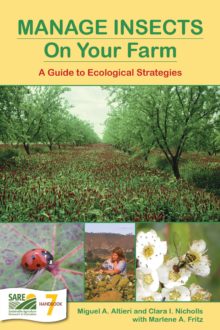Principal Insect Pathogens
Just like humans and other vertebrates, insects are susceptible to many disease-causing organisms known as pathogens. Thousands of species of bacteria, fungi, viruses, protozoa and nematodes can sicken or kill insects. Even if the insects survive, the pathogens’ “sub-lethal” effects can keep their victims from feeding or reproducing.
Bacteria. Most bacteria infect specific insect orders. Some naturally occurring insect-pathogenic bacteria have been isolated and mass-produced for commercial use. One of these, Bacillus thuringiensis or Bt, is the world’s most widely applied biological control agent. It exerts its toxicity only after plant-eating insects actually consume it. A highly dense protein crystal, the Bt toxin kills victims by first paralyzing their mid-gut, then their entire bodies. Like most other bacterial pathogens, Bt is specific to certain insect orders. Its short residual period also makes it an ideal candidate for pest management in fruits and vegetables.
Fungi. Although an estimated 700-plus species of fungi can infect insects, fewer than 20 have been developed for insect management. Most insect-pathogenic fungi need cool, moist environments to germinate. Compared to most other insect pathogens, they have an extensive host range. Beauveria bassiana, for example, can help manage beetles, ants, termites, true bugs, grasshoppers, mosquitoes and mites as well as other arthropod pests. It unleashes a toxin that weakens its host’s immune system, then overwhelms its dead host’s intestinal bacteria with an antibiotic. The tell-tale sign of B. bassiana’s carnage is its victim’s “white bloom” of fungal spores.
Fungi can invade their insect host through natural openings in its cuticle. Thus, hosts need not consume pathogens but only come into direct contact with them. Although some fungi can take up to several weeks to kill their hosts, most infected insects die within three to seven days.
Viruses. Most viruses that attack insects belong to a group called nuclear polyhedrosis viruses or NPVs. Their victims are usually young larvae of butterflies and moths, which become infected by eating NPV particles and typically die within several weeks. Some infected larvae hang limply from the tops of crop canopies, prompting the common name “caterpillar wilt” or “tree top” disease.
Prevailing environmental factors heavily influence the insect-killing efficiencies of viruses. For example, they are adversely affected by sunlight, while the relatively slow speed at which they kill has also hindered their widespread acceptance for biocontrol.
Nematodes. Nearly 40 known families of nematodes parasitize and consume insects and other arthropods. Some are hunter-cruisers while others are ambushers. The most beneficial of these “entomopathogenic” nematodes belong to the Heterorhabditidae and Steinernematidae families. Both families are “obligate” parasites: their survival depends on their hosts and on the symbiotic relationships the nematodes have evolved with disease-causing Xenorhabdus and Photorhabdus bacteria.
Parasitic nematodes transport bacteria inside their host, penetrating the host via the mouth, anus, spiracles or cuticle. Once inside, the nematodes release the bacteria, which quickly multiply and kill the host. In turn, the nematode uses the bacteria and insect cadaver for food and shelter, maturing, mating and reproducing inside it. Infective-stage juvenile nematodes eventually emerge from the cadaver and seek out another host.
Because they are highly mobile and can locate and destroy new victims in just a few days, entomopathogenic nematodes make outstanding candidates for all kinds of biological control. Some are applied to soils to successfully manage the underground life stages of insect pests.
